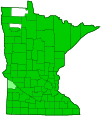long-beaked sedge
(Carex sprengelii)
Conservation • Wetland • Description • Habitat • Ecology • Use • Distribution • Taxonomy
Description |
||
Long-beaked sedge, also called Sprengel’s sedge, is a common, easily recognized, woodland sedge. It occurs across northern United States and southern Canada east of the Rocky Mountains. It is very common and widespread in Minnesota, recorded in all but three counties in the state. It is found in deciduous forests, woodlands, and savannas. It grows under light shade or dappled sunlight in dry to moderately moist, loamy or sandy soil. Long-beaked sedge is an erect, perennial sedge that rises in a loose clump from a horizontal underground, stem (rhizome). It often forms colonies. The rhizome is short, stout, and covered with long coarse fibers. Both sterile (vegetative) and fertile (flowering) shoots are produced, more of the former than the latter. The vegetative shoots are short and are mostly reduced to tufts of basal leaves. The leaves of the previous several years persist, become hair-like, and are densely clustered at the base of the plant. The leaves are 4″ to 15¾″ (10 to 40 cm) long and 1⁄16″ to ⅛″ (2 to 4 mm) wide. They are erect when they first appear, nodding and sometimes creased at the midpoint at maturity. The sheath is hairless, shallowly concave at the tip, white and papery on front, green to papery on back. The sheath of the lowermost leaves is pale brown or straw-colored at the base. The sheaths do not break into horizontal ladder-like fibers as they age, and there is no red or purple coloration at the base of any of the sheaths. They eventually disintegrate into long, conspicuous fibers which persist for several years. The ligule is U-shaped and wider than long. All of the leaves, even at the base, have well-developed blades. The blade is green to light green, long and narrow with straight sides (linear), and flat. The upper surface is hairless but slightly rough to the touch. The lower surface is hairless and smooth. The margins are slightly rough to the touch. Flowering stems are longer than the leaves, 12″ to 36″ (30 to 90 cm) tall, and less than 1⁄32″ (0.5 to 0.7 mm) thick. They are erect, unbranched, leafy, and three-sided with blunt edges. They are hairless, rough to the touch near the top, and tinged brownish at the base. Stem leaves are alternate and ascending to widely spreading. The inflorescence is 1 to 3 male (staminate) spikes crowded at the tip of the stem and 2 to 3 female (pistillate) spikes widely spaced near the top of the stem. Staminate spikes are white to straw-colored, narrowly cylinder-shaped, linear, stalkless or nearly stalkless, ⅜″ to ¾″ (10 to 35 mm) long, 1⁄16″ (1.5 to 2.0 mm) wide. They sometimes have a few pistillate florets at the base. Pistillate spikes are cylinder-shaped, ⅜″ to 1⅜″ (10 to 35 mm) long, and 5⁄16″ to ⅜″ (8 to 10 mm) wide. Most are on slender, nodding or drooping, ¾″ to 4″ (2 to 10 cm) long stalks. Each spike has 10 to 40 fruit capsules (achenes), and each achene has a sac-like covering (perigynium). The perigynia are somewhat separated, not crowded. At the base of each perigynia is a single modified bract (scale). The scale is lance-shaped to egg-shaped, ⅛″ to 3⁄16″ (3.5 to 5.0 mm) long, and tapered to a long pointed tip. It is longer than the body of the perigynium but slightly shorter than the beak. It is mostly papery and straw-colored with a narrow green midrib. Each pistillate flower has 3 long, slender stigmas. The perigynium is egg-shaped (widest at the base) to ellipse-shaped (widest in the middle), 3⁄16″ to 5⁄16″ (4.5 to 7.7 mm) long, 1⁄16″ (1.5 to 2 mm) wide, and circular or nearly circular in cross section. It entirely and tightly envelopes the achene at maturity. It is abruptly contracted into a long beak at the tip. The main body of the perigynia is papery, golden green to nearly straw-colored, and somewhat shiny. It has a single rib on each side but no other obvious veins. The beak is tube-shaped, about as long as the main body, and has two papery teeth at the tip. The long stigmas projecting from the beak persist as the achene matures. The achene is dry, yellowish-brown, 1⁄16″ (2.0 to 2.5 mm) long, and triangular in cross section. It matures in mid-May to early June. |
||
Height |
||
12″ to 36″ (30 to 90 cm) |
||
Similar Species |
||
Habitat |
||
Dry to moderately moist. Deciduous forests, woodlands, and savannas. Light shade or dappled sunlight. Loamy or sandy soil. |
||
Ecology |
||
Maturing |
||
Mid-May to early June |
||
Pests and Diseases |
||
|
||
Use |
||
|
||
Distribution |
||||
|
Sources 2, 3, 4, 5, 7, 28, 29, 30, 84. The only record in Lac qui Parle County is from 1979 and is questionable. |
|||
| 3/24/2022 | ||||
Nativity |
||||
Native |
||||
Occurrence |
||||
Very common and widespread in Minnesota |
||||
Taxonomy |
|||
| Kingdom | Plantae (Plants) | ||
| Division | Tracheophyta (Vascular Plants) | ||
| Subdivision | Spermatophytina (Seed Plants) | ||
| Class | Liliopsida (Monocots) | ||
Order |
Poales (grasses, sedges, cattails, and allies) | ||
Family |
Cyperaceae (sedges) | ||
| Subfamily | Cyperoideae | ||
| Tribe | Cariceae | ||
Genus |
Carex (true sedges) | ||
| Subgenus | Carex | ||
| Section | Hymenochlaenae | ||
Synonyms |
|||
|
|||
Common Names |
|||
long-beak sedge long-beaked sedge longbeak sedge Sprengel sedge Sprengel’s sedge |
|||
Glossary
Achene
A dry, one-chambered, single-seeded seed capsule, formed from a single carpel, with the seed attached to the membranous outer layer (wall) only by the seed stalk; the wall, formed entirely from the wall of the superior ovary, does not split open at maturity, but relies on decay or predation to release the contents.
Beak
A comparatively short and stout, narrow or prolonged tip on a thickened organ, as on some fruits and seeds.
Bract
Modified leaf at the base of a flower stalk, flower cluster, or inflorescence.
Ligule
In grasses and sedges, an outgrowth on the leaf at the junction of the blade and the sheath, usually membranous, sometimes no more than a fringe of hairs. In flowering plants, the ligule is the flat, strap-shaped, petal-like portion of the corolla of a ray floret.
Linear
Long, straight, and narrow, with more or less parallel sides, like a blade of grass
Perigynium
In Carex and other closely related sedges, a sac-like or flask-shaped, highly modified bract that surrounds the pistillate flower and later encloses the achene. Plural: perigynia.
Pistillate
Referring to a flower that has a female reproductive organ (pistil) but does not have male reproductive organs (stamens).
Rhizome
A horizontal, usually underground stem. It serves as a reproductive structure, producing roots below and shoots above at the nodes.
Scale
In plants: A small, usually flat and thin, modified leaf resembling the scale of a fish. In sedges: A dry, reduced bract at the base of the perianth. In animals: A small rigid plate growing out of an animal’s skin to provide protection. In butterflies and moths: A plate on the surface of the wing providing coloration.
Sheath
The lower part of the leaf that surrounds the stem.
Spike
The arrangement of an unbranched, elongated inflorescence with stalkless flowers that mature from the base toward the tip. In Cyperaceae, it also denotes a collection of one or a group of stalkless flowers, each subtended by scales, on a single inflorescence axis.
Spikelet
In flowering plants, a small spike. In grasses and sedges, the basic unit of inflorescence. In grasses, composed of usually two glumes and one or more florets. In sedges, a single flower and its single associated scale
Staminate
Referring to a flower that has a male reproductive organs (stamens) but does not have a female reproductive organ (pistil).
Stigma
In plants, the portion of the female part of the flower that is receptive to pollen. In Lepidoptera, an area of specialized scent scales on the forewing of some skippers, hairstreaks, and moths. In Odonata, a thickened, dark or opaque cell near the tip of the wing on the leading edge.
Visitor Photos |
|||||
Share your photo of this plant. |
|||||
| This button not working for you? Simply email us at info@MinnesotaSeasons.com. Attach one or more photos and, if you like, a caption. |
|||||
|
|||||
MinnesotaSeasons.com Photos |
|||||
Plant |
|||||
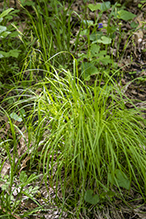 |
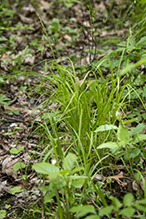 |
||||
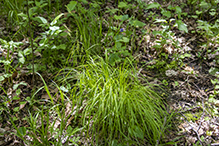 |
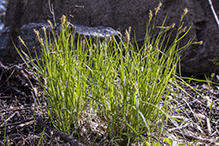 |
||||
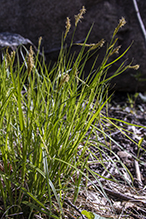 |
|||||
Inflorescence |
|||||
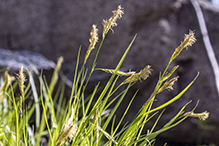 |
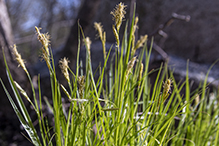 |
||||
Infructescence |
|||||
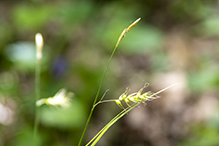 |
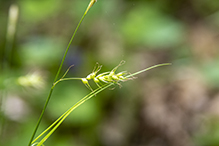 |
||||
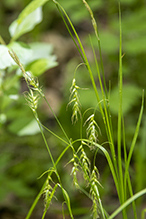 |
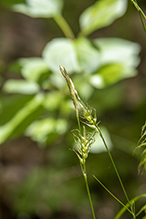 |
||||

Slideshows |
||
| Carex sprengelii - Sprengel's sedge Matt Lavin |
||

|
||
About
Sprengel's sedge is a native rhizomatous and loosely bunched sedge often growing in lush open understory including alongside trails and on steep slopes. Standing usually 30-50 cm tall, the pistillate spikes are pendant and each spike bears many perigynia, which have abruptly contracted beaks that are longer than the perigynia body and that lack a bifid tip. |
||

Visitor Videos |
|||
Share your video of this plant. |
|||
| This button not working for you? Simply email us at info@MinnesotaSeasons.com. Attach a video, a YouTube link, or a cloud storage link. |
|||
Other Videos |
|||

Visitor Sightings |
|||||
Report a sighting of this plant. |
|||||
| This button not working for you? Simply email us at info@MinnesotaSeasons.com. Be sure to include a location. |
|||||
|
|||||
MinnesotaSeasons.com Sightings |
|||||

Created: 2/29/2020
Last Updated:
